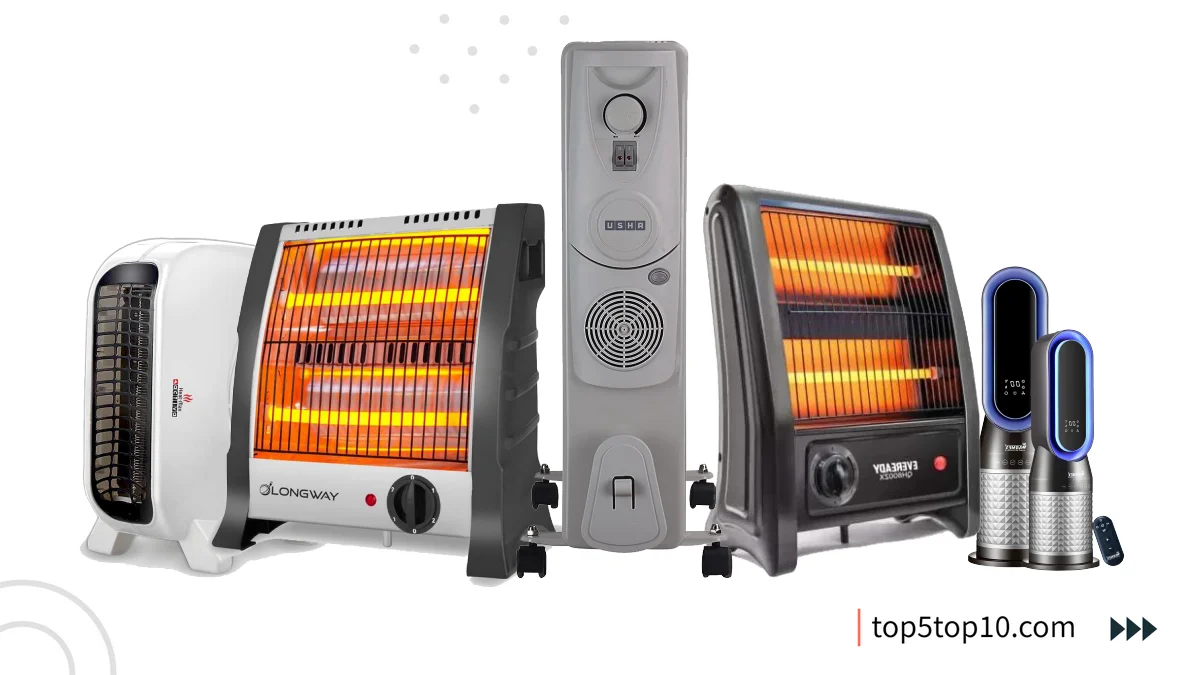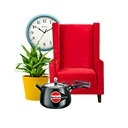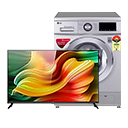
Room Heater Types – When the chilly weather sets in, room heaters become our trusty companions, providing warmth and comfort in homes and offices alike.
But with various types of room heaters available, it’s essential to understand the differences, advantages, and ideal use cases for each.
In this comprehensive guide, we’ll explore the world of room heaters, covering everything from convection and radiant heaters to smart and energy-efficient options.
So, whether you’re looking to stay toasty during winter or create a cozy ambiance, read on to discover the perfect room heater for your needs.
Contents
1. Convection Heaters
Convection heaters are a popular choice for efficiently heating enclosed spaces. They operate on the principle of convection currents, where air is heated, rises, and circulates, creating a consistent warmth throughout the room.
1.1 Advantages of Convection Heaters:
- Even Heating: Convection heaters provide uniform heating, ensuring there are no cold spots in the room.
- Silent Operation: They operate quietly, making them suitable for bedrooms and offices.
- Energy Efficiency: Convection heaters are energy-efficient, as they maintain a steady temperature without constant cycling.
1.2 Disadvantages of Convection Heaters:
- Slower Heating: They may take a bit longer to heat a room compared to some other heater types.
- Not Ideal for Large Spaces: In larger rooms, their efficiency may decrease, and additional units may be needed.
1.3 Common Uses:
Convection heaters are excellent for bedrooms, living rooms, and offices, where even heating and silence are essential.
2. Radiant Heaters
Radiant heaters, also known as infrared heaters, work by emitting electromagnetic waves that directly heat objects and people in their path rather than heating the air. They provide quick and focused warmth.
2.1 Advantages of Radiant Heaters:
- Instant Warmth: Radiant heaters provide almost instant heat as soon as they are turned on.
- Focused Heating: They are ideal for spot heating, making them efficient for specific areas.
- Silent Operation: Radiant heaters operate quietly, without fans or blowers.
2.2 Disadvantages of Radiant Heaters:
- Localized Heating: They primarily warm the area directly in front of them and may not heat an entire room evenly.
- Not Ideal for Drafty Spaces: In drafty rooms, the heat may disperse quickly, reducing effectiveness.
2.3 Common Uses:
Radiant heaters are suitable for garages, workshops, and spaces where focused heating is required.
No products found.
3. Oil-Filled Radiator Heaters
Oil-filled radiator heaters are known for their ability to retain heat, making them energy-efficient and long-lasting.
They use diathermic oil as a heat reservoir and transfer heat to the room through metal fins.
3.1 Advantages of Oil-Filled Radiator Heaters:
- Energy Efficiency: They maintain heat well and require less energy to operate.
- Silent Operation: Oil-filled radiators operate quietly without fans or blowers.
- Long-lasting Warmth: They continue to emit heat even after being turned off, making them suitable for consistent heating.
3.2 Disadvantages of Oil-Filled Radiator Heaters:
- Slow Heating: They may take some time to reach the desired temperature.
- Heavier and Bulky: These heaters can be heavier and less portable due to the oil reservoir.
3.3 Common Uses:
Oil-filled radiators are excellent for bedrooms, living rooms, and other spaces where steady warmth is needed.
4. Ceramic Heaters
Ceramic heaters employ a ceramic heating element and a fan to distribute warmth. They are known for their quick heating and versatility.
4.1 Advantages of Ceramic Heaters:
- Rapid Heating: Ceramic heaters heat up quickly, providing almost instant warmth.
- Compact Design: They are often compact and portable, making them easy to move from room to room.
- Even Distribution: The built-in fan ensures even heat distribution in the room.
4.2 Disadvantages of Ceramic Heaters:
- Fan Noise: The fan can produce noise, which may be bothersome in quiet settings.
- Limited Range: They are suitable for small to medium-sized spaces but may not be effective in larger rooms.
4.3 Common Uses:
Ceramic heaters are versatile and can be used in bedrooms, offices, and small living spaces.
5. Fan Heaters
Fan heaters, also known as forced fan heaters, use a fan to blow air over heated elements and distribute warm air into the room.
5.1 Advantages of Fan Heaters:
- Quick Heating: They provide rapid heating, making them suitable for on-demand warmth.
- Compact: Fan heaters are often compact and portable, fitting well in small spaces.
- Affordability: They are usually more budget-friendly than some other heater types.
5.2 Disadvantages of Fan Heaters:
- Noise: The fan can produce noise during operation, which may be distracting.
- Air Drying: Continuous use in dry climates can contribute to dryness in the air.
5.3 Common Uses:
Fan heaters are ideal for bathrooms, small offices, and areas where quick heating is required.
6. Infrared Heaters
Infrared heaters use infrared radiation to heat objects and people directly, similar to the sun’s warmth. They emit radiant heat, creating a cozy atmosphere.
6.1 Advantages of Infrared Heaters:
- Efficient Heating: They provide instant and efficient heat without warming the entire room.
- Silent Operation: Infrared heaters operate silently since they do not use fans.
- Energy Efficiency: They use less energy because they heat specific targets rather than the entire space.
6.2 Disadvantages of Infrared Heaters:
- Localized Heating: Like radiant heaters, they primarily heat the area in front of them.
- Not Ideal for Large Spaces: Infrared heaters are best suited for smaller areas.
6.3 Common Uses:
Infrared heaters are perfect for patios, garages, and outdoor spaces, where spot heating is needed.
7. Panel Heaters
Panel heaters, also known as wall-mounted heaters, are sleek and flat heating units that can be mounted on walls to save floor space.
7.1 Advantages of Panel Heaters:
- Space-saving: They are wall-mounted, saving valuable floor space in smaller rooms.
- Efficient: Panel heaters are energy-efficient and often have programmable features.
- Even Heat Distribution: They distribute heat evenly across the room.
7.2 Disadvantages of Panel Heaters:
- Installation Required: Mounting may require some installation work.
- Slower Heating: They may take a bit longer to heat a room compared to some other types.
7.3 Common Uses:
Panel heaters are suitable for bedrooms, living rooms, and offices with limited floor space.
No products found.
8. Halogen Heaters
Halogen heaters utilize halogen bulbs to generate heat, similar to incandescent light bulbs. They emit instant warmth and are known for their portability.
8.1 Advantages of Halogen Heaters:
- Quick Heating: Halogen heaters provide rapid heat, making them suitable for quick warmth.
- Portability: They are often lightweight and portable, easy to move around.
- Focused Heating: Halogen heaters offer spot heating, concentrating warmth where needed.
8.2 Disadvantages of Halogen Heaters:
- Bright Light: The intense light emitted by halogen bulbs may be bothersome to some users.
- Limited Range: They are ideal for small to medium-sized spaces but may not heat larger rooms effectively.
8.3 Common Uses:
Halogen heaters are excellent for personal spaces like home offices or reading nooks.
No products found.
9. Heat Pumps
Heat pumps are energy-efficient heating solutions that extract heat from the outside environment and transfer it indoors. They work well for both heating and cooling.
9.1 Advantages of Heat Pumps:
- Energy Efficiency: Heat pumps are highly energy-efficient and environmentally friendly.
- Year-round Use: They can be used for both heating and cooling, making them versatile.
- Consistent Temperature: Heat pumps provide consistent and even heating.
9.2 Disadvantages of Heat Pumps:
- Initial Cost: They may have a higher upfront cost than traditional heaters.
- Climate-dependent: Their efficiency may vary based on the local climate and temperature.
9.3 Common Uses:
Heat pumps are ideal for year-round heating and cooling in homes and businesses.
10. Smart Heaters
Smart heaters are modern, connected devices that can be controlled remotely via smartphones or integrated into smart home systems.
10.1 Advantages of Smart Heaters:
- Remote Control: They can be controlled and monitored remotely for convenience.
- Energy Efficiency: Smart heaters often come with energy-saving features and scheduling options.
- Integration: They can be integrated into smart home ecosystems for seamless control.
10.2 Disadvantages of Smart Heaters:
- Initial Cost: Smart heaters may be more expensive than traditional models.
- Complexity: Setting up and configuring smart heaters may require technical know-how.
10.3 Common Uses:
Smart heaters are suitable for tech-savvy users who want convenient, energy-efficient heating solutions.
11. Comparison Table
here’s a comparison table that summarizes the key features of each room heater type along with example products available on Amazon:
| Room Heater Type | Example Product | Advantages | Disadvantages | Common Uses |
|---|---|---|---|---|
| Convection Heater | De’Longhi Oil-Filled Radiator Space Heater | Even Heating | Slower Heating | Bedrooms, Living Rooms, Offices |
| Radiant Heater | Dr Infrared Heater Portable Space Heater | Instant Warmth | Localized Heating | Garages, Workshops, Spot Heating |
| Oil-Filled Radiator Heater | COSTWAY Oil Filled Radiator Heater | Energy Efficiency | Slow Heating | Bedrooms, Living Rooms, Steady Heating |
| Ceramic Heater | Lasko Ceramic Tower Heater | Rapid Heating | Fan Noise | Bedrooms, Offices, Small Spaces |
| Fan Heater | Lasko Ceramic Portable Space Heater | Quick Heating | Fan Noise | Bathrooms, Small Offices, Quick Heating |
| Infrared Heater | Dr Infrared Heater DR-975 Hardwired Shop Garage Heater | Efficient Heating | Localized Heating | Patios, Garages, Spot Heating |
| Panel Heater | Heat Storm Deluxe Mounted Space Infrared Wall Heater | Space-saving Design | Slower Heating | Bedrooms, Living Rooms, Wall-Mounted |
| Halogen Heater | Optimus H-4110 9-Inch Dish Heater | Quick Heating | Bright Light | Personal Spaces, Quick Spot Heating |
| Heat Pump | Della 12000 BTU Mini Split Air Conditioner Heater | Energy Efficiency | Initial Cost | Year-round Heating and Cooling |
| Smart Heater | Amazon Smart Plug (for controlling non-smart heaters) | Remote Control, Energy Savings | Initial Cost, Complexity | Smart Homes, Convenient Heating |
When choosing a room heater, consider your specific needs, room size, and heating preferences to select the most suitable type and model for your space.
12. Conclusion
Choosing the right room heater type is essential to meet your specific heating needs and preferences.
Each type of room heater offers unique advantages and disadvantages, making them suitable for various situations.
Whether you prioritize quick heating, energy efficiency, or quiet operation, there’s a room heater type that fits the bill.
Consider the size of the space, your budget, and your heating requirements when selecting a room heater.
Whichever type you choose, you’ll be able to enjoy a warm and cozy environment during the chilly months.
With this comprehensive guide, you are now equipped with the knowledge needed to make an informed decision and stay warm and comfortable year-round.
13. Room Heater Types FAQs
What are the different types of room heaters?
There are several types of room heaters, including:
- Convection Heaters: These heaters warm the air and circulate it, creating even heating throughout the room. They are suitable for larger spaces.
- Radiant Heaters: Radiant heaters emit infrared radiation that directly heats objects and people in their path. They are ideal for spot heating.
- Oil-Filled Heaters: These heaters contain a reservoir of thermal oil, which is heated and radiates warmth. They are energy-efficient and provide consistent heat.
- Fan Heaters: Fan heaters blow air over a heating element, quickly distributing warm air throughout the room. They are effective for small to medium-sized spaces.
- Halogen Heaters: Halogen heaters use halogen bulbs to generate heat, providing instant warmth. They are compact and suitable for smaller areas.
Which type of room heater is the most energy-efficient?
Oil-filled heaters are often considered the most energy-efficient room heaters.
They provide consistent and long-lasting heat, as the oil retains warmth even after the heating element is turned off.
This can help reduce energy consumption and save on heating costs.
Are radiant heaters safe to use in bedrooms or around children?
Radiant heaters are generally safe to use in bedrooms or around children.
They do not have a fan, making them quieter, and they do not blow dust or allergens around. However, they can become very hot, so it's essential to keep them out of reach of children and away from flammable materials.
Do fan heaters provide quick heating in small rooms?
Yes, fan heaters are known for providing quick and efficient heating in small rooms.
They use a fan to distribute warm air rapidly, which can help raise the room's temperature within a short period, making them ideal for small spaces.
What are the advantages of using halogen heaters?
Halogen heaters have several advantages, including:
- Instant Heat: Halogen heaters provide instant warmth as the halogen bulbs heat up quickly.
- Compact and Portable: They are typically small and lightweight, making them easy to move and store.
- Quiet Operation: Halogen heaters are quiet during operation, making them suitable for bedrooms or quiet spaces.
- Cost-Effective: They are often affordable to purchase, making them an economical heating solution.
|
Related Tags
Room heater types in india, Portable room heater types, Best room heater types, which room heater is best for health, types of heaters for home, oil filled room heater, types of heater in industry, types of heater in injection moulding
Last update on 2024-05-20 at 14:51 / Affiliate links / Images from Amazon Product Advertising API

















